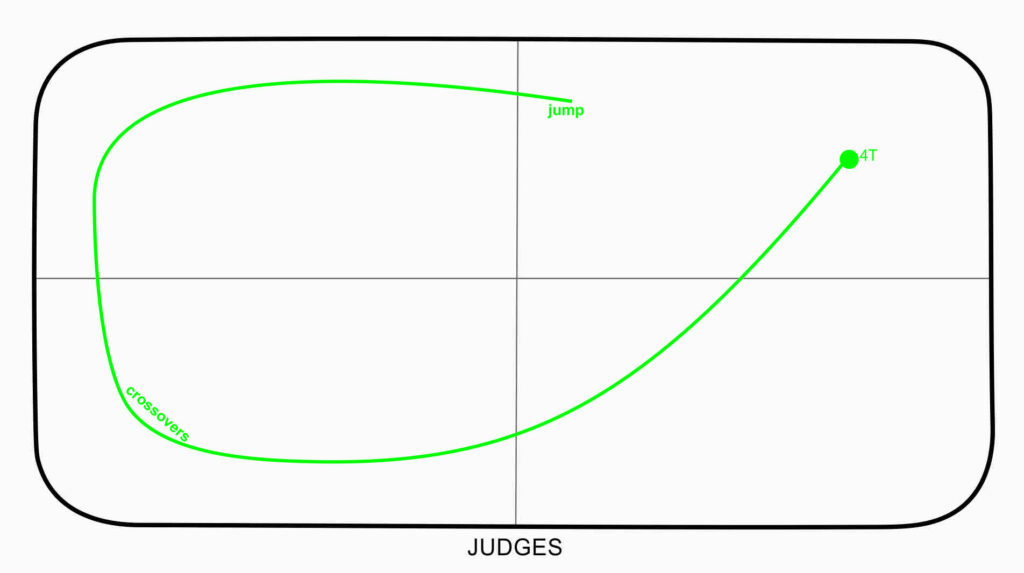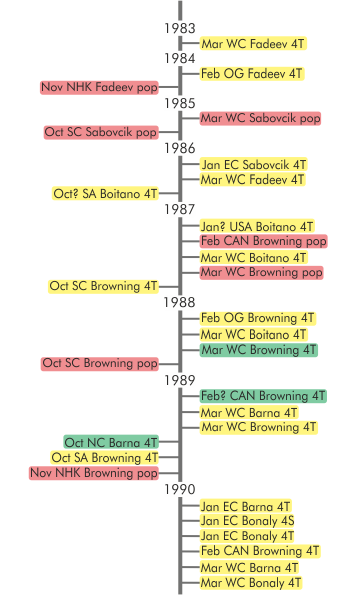The triple jumps had become staples in men’s figure skating starting from the 1950s, but quadruples were already looming around the corner in the early 1980s. Before Kurt Browning’s (CAN) first ratified quadruple toe loop in 1988, there were other skaters who tried but could not quite make it.
The data is sketchy for the seasons before the 1983 Worlds as seen from the prehistory of quads (see the first part of the quadstory), but since then it is possible to find videos of competitions, newspaper articles mentioning jumps, as well as very early social media reports on competitions. (The links in the names lead to Wikipedia pages.)
But the verified first attempt in a competition was not far away. Alexander Fadeev, a Soviet skater, got the honor for the first quadruple toe loop attempted in the free skate at the 1983 World Championships in Helsinki, Finland. Men’s free program was skated on a Thursday evening, March 10. The available footage is from a Japanese broadcast and the commentator’s awed “yonkaiten” (‘four revolutions”) underlines the importance of the moment.
Fadeev was 19 during the Worlds in 1983. After that, he tried the 4T at least three times in four seasons (plus did at least one pop), but never got an ISU ratified clean jump. His total jump count could be higher than three as only about half of his competitive performances can be found online and mentions in newspaper articles are rare. The few interviews of Fadeev in English available do not even mention his pioneering role in the history of quads.
Looking at Fadeev’s 4T attempts from the point of view of program layout leaves one astounded. The toughest elements are usually placed at the start of the program – the skater is still fresh and focused – and this applied also in the 1980s. In Fadeev’s case, the 4T was in the middle of the program after a busy first minute (3A in combination, 2A into a spin, 3Lz in combo, steps, and a second spin). Then the music slows down, Fadeev has a slight breather before going for the quad. His last quad attempt in 1986 was even later in the program.
The approach to the 4T becomes familiar over time as most men did the same thing (still quite a popular pattern for the 4T): crossovers in the corner followed by a diagonal straight line across the ice and the jump roughly in the middle of the opposite short side. He enters the jump from a right foot 3-turn outside edge with the left leg reaching behind.

The second man to attempt a quad in competition was Josef Sabovcik (CZE) and he almost got the first clean 4T in the 1986 Europeans. It was first ratified, but after weeks of scrutiny, the ISU decided that his free leg touched the ice at the landing.
He had turned 23 at the time and it was the last competitive season for him. Sabovcik was training and attempting the quad already earlier in the season with some pops as a result. There is also some practice footage of him and even a bit of a quad battle with Brian Orser (CAN) (watch it on YouTube). Also in Sabovcik’s case, videos of his skates are rare, but all the attempts are from the 1985–86 season.
His 4T was placed in the first part of the program after a 3A and a 3F, just before the 1-minute mark. His approach pattern started from one corner and followed a curving line to the opposite corner. His jump took off after a left foot 3-turn to the right foot outside edge and left leg back. The way he stops to celebrate for a moment after the attempt shows how much it meant!

Brian Orser was seen jumping 4Ts in a practice video with Jozef Sabovick in the mid-1980s (link above), but he never tried one in competition. In 2018 he said: “And, you know, in practice I would do quad toe loops, but it was different in competitive skating. You couldn’t take a big risk. So even though I was landing some quad toe loops, but to go out there and take that risk, and if I fell – basically it’s over. The Olympic champions did not fall then. You had to have a clean program, and it was safe, and it was beautiful, and it was choreographed. But now we have a point system, so you could take that risk. You could fall and still get some points for that element.” (Inside Skating interview, Feb 15, 2018.)
Another top skater in the late 1980s who apparently trained quads but never tried them in competition was Viktor Petrenko (USSR/UKR). According to one source (a biography on a sports page) he got injured training quads in the fall 1988: “Petrenko had mastered the triple axel at age sixteen but was never completely comfortable with quadruple spins. In practicing to perfect his quadruple toe loop after the Skate Canada meet in 1988 he tore a muscle in his pelvis and spent weeks away from the ice in a painful recuperation.”
The Battle of the Brians over quads was won by Brian Boitano (USA). He tried the 4T at least four times in competition, the first was at the 1986 Skate America. Almost all Boitano’s performances in competitions for those years are available online and the four jumps in two seasons is probably an accurate total count. He never got a completely clean quad in his record. There is also some practice footage.
Boitano was almost 23 years old when he first attempted a quad in competition. It came out in the middle of the first part – the Tano 3Lz got the honor to be the first element and Boitano also did a 3A+2T combination before hitting the 4T. The last time, though, the 4T was the second element after the 3Lz. The entry pattern was similar to the other men, but he jumped closer to center ice than the others. His lift-off comes from right foot outside 3-turn.

In an interview after the free at the US Nationals in 1987, he states that he is not giving up on the quad just in case everyone else showed up at the Worlds with one. He really needn’t have worried as only Kurt Browning tried (and popped) a quad that year. The quad proved to be so unimportant that Boitano actually tried it only once more during the following season 1987–88.
This brings us to the first actual ratified 4T: Kurt Browning (CAN) at the World Championships in 1988. He has described the process that led to the first tries in the 1987–88 season on many occasions. Browning started training in secret and the first time the result was revealed was at the gala of the Nebelhorn Trophy in August 1986 (The Kurt Files Memory Lane). He was maybe training it in public practices at the NHK Trophy 1987 as the commentators of the broadcast were half expecting him to try it, talking about a quad and then counting only three revolutions from the slow-motion repeat.
Browning’s first official attempt took place at the Skate Canada 1987 when he was 21 years old. The second try was at the Olympics in 1988, and he fell, but third time’s a charm and at the Worlds he got one clean (the warm-up quad shown in the clip is even better).
Browning went on to try the 4T at least nine times in four seasons and about 25 competitions. This count is probably fairly accurate as videos are available for most of his competitions. He was also taking the risk of failure as he popped quite a few attempts when others chose not to even try.
Browning’s first attempt was placed as the last element in the program (no wonder it did no go that well!). The second time it was moved to the middle of the program. The first successful jump was at the top of the program and in layouts after that, the quad was usually in the first part. The entry pattern was the one used by most of his peers, and he also used the left foot 3-turn to right foot lift-off. He was also dabbling with the quadruple Salchow (Stevens 2023, 30) in practices and recently revealed that for a very short period he was also training a quad Axel (a long conversation with Elvis Stojko on YouTube).

The last skater to try the quad in the 1980s was Petr Barna (CZE) who was the first European to jump a ratified 4T. His career is not particularly easy to trace – videos and mentions in the media are rare. It seems that he started to attempt quads in 1989 – possibly already at the Worlds. In the fall of 1989 at the Nations Cup in Germany (The Globe and Mail 2008) he went clean – no video exists unfortunately, but the source states it was a clean one. He is officially the first European skater to do a quad. He two-footed the attempts at the Europeans and Worlds later that season. It does not seem that he tried the quad in the 1990–91 season, but his last season (1991–92) featured three attempts and the one at Olympics
Barna was 23 at the time of the first attempts. The first element of the free skate was a 3Lz combination followed by the 4T. His total was six tries in three seasons although there could be more.
Although the early history of quads is mostly about men, it is worth remembering the single woman who was going for quads when few men dared to dream of them: Surya Bonaly (FRA). The 16-year-old Bonaly became the sixth skater to attempt a quad when she went for both the quad toe and the quad Sal in her free at the Europeans in January 1990. She became the first woman and skater of color to try quads.
But she did more than that! Bonaly was the first skater to try the Sal, to try two different quads, and the first to try them in the same program. Bonaly attempted a quad 13 times before the end of the 1995–96 season and as her career is very well-documented, this is probably correct. Her career total is the second highest among the quadsters of the time – only Elvis Stojko (CAN) got more (45). It is a pity that Bonaly never got a clean quad, she would have deserved it!
Summing up the 1980s is both easy and difficult. Only five men and one woman attempted quads in competition between 1982 and 1990 with certainty: Fadeev, Sabovcik, Boitano, Browning, Barna, and Bonaly. Only two are known to have trained beyond that group, but I suspect there could have been more. The total number of jumps in competition is only 22 in eight seasons – in addition to that, seven pops could be found. Two different types of quads were attempted: 4T and 4S. Three of those 22 jumps were probably considered clean at the time. Three of the jumps took place in a domestic competition. The 1987 Worlds was the first time ever with two quad attempts as both Boitano and Browning went for them. Most skaters preferred to have the quad towards the middle of the program which might partially explain the problems.
It seems that everyone expected everyone else to pick up the quad immediately, but the revolution started quite slowly.
This is what the 1980s quads look like on a timeline:

The 1980s summed up in a table. “New” means numbers of new quadsters. “Quad King” is the skater with most quad attempts that season. “Layouts” refers to how the numbers of quads planned for short and free programs – at this time, no quads were allowed in the short.

3 thoughts on “From Dreaming to Reality: The 1980s and Quads”